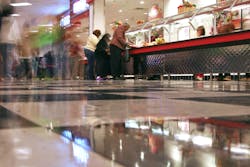Quick Service Restaurant Visits Decline For The First Time In Five Years
A confluence of squeezed consumer wallets, the rising cost of dining out, and changing needs and wants has brought the U.S. restaurant industry traffic growth to a halt in the first two quarters of 2016 and into the negative in the third quarter, reports The NPD Group.
Total foodservice visits declined by 1 percent in the third quarter compared to same quarter last year, and quick service restaurant traffic, which represents 80 percent of total industry visits, dropped for the first time in five years, according to NPD’s ongoing foodservice market research.
“The term growing your business in a ‘one percent world’ has become a popular mantra for the restaurant industry after six consecutive years of annual traffic gains of just one percent,” says Bonnie Riggs, restaurant industry analyst at NPD. “However, over the past six months restaurant industry traffic growth has come to a standstill and quick service restaurants, which have been the traffic growth drivers, are now experiencing a slowdown in visits.”
Riggs, who recently authored a report entitled, Losing Our Appetites for Restaurants, points out that there are multiple reasons why consumers have pulled back on visiting restaurants and chief among them is cost. She states in her report that rising healthcare costs and/or student debt have reduced the amount of disposable income consumers have in their wallets. According to a survey of the longitudinal panelists participating in NPD’s receipt mining service, Checkout Trackingsm, 75 percent of the respondents who have decreased their visits to restaurants say they watch how they spend their money on most or all purchases, and a high percentage of these respondents think that restaurant prices are too high. The fact is the cost of the average restaurant meal has risen 21 percent over the last decade and with lower grocery prices the price gap between eating at home and dining out is widening. Eighty-two percent of all meals are now consumed in-home.
“The marketplace is changing and despite improving economic indicators, the consumer landscape is fundamentally reshaped,” says Riggs. “What hasn’t changed and won’t change is the consumer’s need for foodservice; it saves them time and provides them with an experience. Restaurant operators will need to look for ways to differentiate themselves from the competition. They will need to find the means to stay relevant in consumers’ minds – innovative products, unique promotions, competitive pricing, stating the benefits of eating at restaurants compared to home – while delivering an enjoyable experience.”
